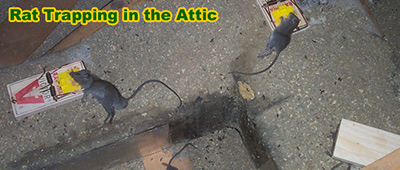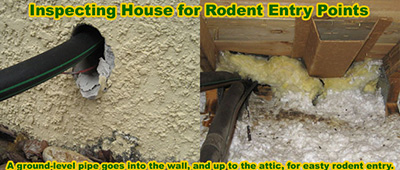This website is obviously about rats in attics of homes, but they can get into all sorts of buildings. I've removed rats from dental offices,
food warehouses, furniture stores, fast food chains, fancy restaurants, an orange juice factory, and so on.
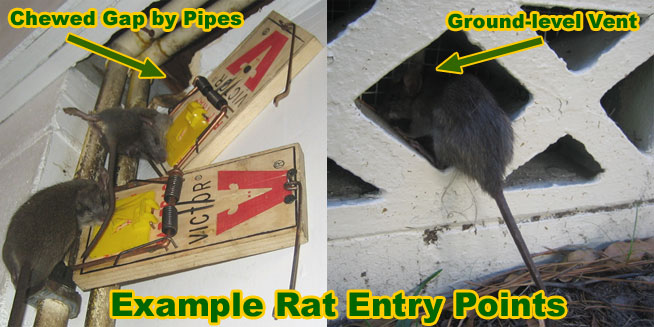
Rats need food, water, and shelter. Any building can provide shelter, and if there are a lot of small, enclosed spaces that a rat can fit into, all the better.
RATS IN A RESTAURANT
Oh, the best of all worlds! Shelter AND food! Yes, there's a reason why rats are common in restaurants and kitchens throughout the world. These crafty rodents will live wherever they
can find food and shelter, and restaurants fit the bill. There's food, oh yes, LOTS of food! It's often just thrown out. It doesn't matter if your restaurant is clean, and your
kitchen spotless. There's still going to be shelter and food there, so rats will live in a diner or fast food joint or fancy eatery, SO LONG AS THERE ARE OPENINGS THAT LEAD INTO THE BUILDING. It
all comes down to the openings. You can have the nastiest, dirtiest restaurant in the world, but if there are no openings for rats to get inside the building, you won't have rats. And if you
have the neatest, cleanest, most sanitary kitchen in the world, but there are ways for rats to get into the building - open vents, ducts, etc, well then, you're going to have rats inside.
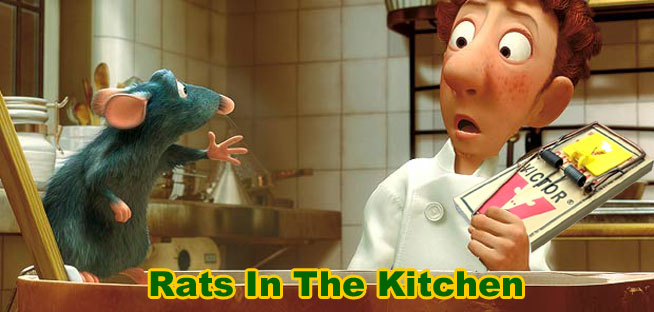
RATS IN A WAREHOUSE
I've removed rats from warehouses several times, including from some huge food warehouses of large companies that I won't list here. No big deal, it's just a fact of the matter in the world
we live in. I think there's like a certain allowable percentage of rat feces in the food we eat anyway. Still, you want to limit rat damage and disease as much as possible, so as usual,
it all comes down to openings into the building. The problem with warehouses is that they have large cargo bay doors, and there is practically no way to properly seal some of these doors. I guess
maybe they make rat-proof ones, but the warehouses I went to were lost causes - and many have to keep doors open during night-time hours. In a case such as this, it's perhaps best just to
keep rat populations down as much as possible by limiting food sources, and leaving out tamper-proof rat-trapping stations. I still say that poison is a very bad idea.
RATS IN A FACTORY
Same explanation as the warehouse above. A large industrial building can have many entry points, and some of them are impractical to seal shut. In some types of factories, impossible. I did a lot
of rat removal work at a citrus processing plant in Florida, and I really didn't see any way of sealing up those huge buildings. I guess, with a lot of time and effort it could have been done, but
they never hired me to do so. The just called me out whenever a dead rat (or two) was really stinking up an area. That's what they get for using poison. I tried to offer a better solution, but
they had some pest control contract that they wanted to keep, so... whatever.
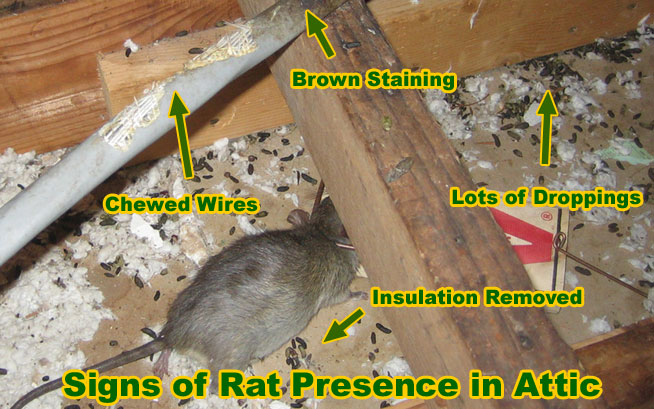
Keep an eye out for rat in the toilet as well, which can sometimes happen when they come through the plumbing lines.
THE SAME APPLIES TO MICE
Although I wrote this site with rats in mind, such as the Roof Rat and Norway Rat, the same principles apply to other rodents, such as the house mouse. Mice
behave very similarly to rats, they're just smaller. Email me if you have any questions about how to remove a mouse in the kitchen or restaurant, mice in buidlings, mice in restaurants, rodents in
commercial buildings, and so on.

Tips to Get Rid of Rats in the Attic
If you have rats invading your home, chances are they are looking for one of two things which, unfortunately for you, they have managed to find: food and shelter. Like all household pests, rats need a reliable source of food and a warm, safe shelter to survive, and thanks to their remarkable intellect, agility, and adaptability rats have become experts at getting what they want.
For starters, rats can easily squeeze through gaps far smaller than they are, and if given the opportunity can scramble around your house via the pipes in your walls and under the floors. They also make decent climbers which, when combined with nearby trees, give them near-unlimited access to your roof and, eventually, your attic.
Getting rid of rats in the attic can be difficult, but it must be done quickly and effectively for a number of reasons. To start, they are notorious for spreading diseases, especially through their droppings and urine, which will only compound if left unchecked. They also chew on hard surfaces which can damage your home, in particular electrical cables which can lead to house fires.
Without proper removal, rats will come back as quickly as you remove them, so it needs to be done right. For starters, you should never use rat poison inside your home, because a dead rat can be even worse to handle and lead to even worse health risks. Similarly, it is not worth using repellants as rats constantly adapt to overcome them.
Instead, your only choice is to seal off your home as much as possible from invading rats, including any gap you think they might be able to get into, keep any food source out of reach in sealed containers, and then use lots of traps to capture those that reside in the attic.
It is best to use a combination of trap types, including snap and glue traps, or if possible live traps, because you could be dealing with dozens of rats depending on how long it takes to discover it. Bait choice is also important; contrary to popular belief, rats do not actually prefer eating cheese. Instead, use something sweet like peanut butter.
Then make sure your traps are in the right places by identifying where their common entrance/exit holes are and routes they run along. If possible, try to disguise the traps, as rats are smart enough to avoid them.
Traps need to be checked regularly, and any caught need to be safely removed with protective equipment before the traps are reset. Once you are sure the rats have been dealt with, you will then need to thoroughly clean and disinfect the attic to kill off any leftover diseases and do another inspection to make sure any future rats cannot find a way inside.


